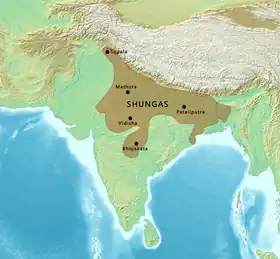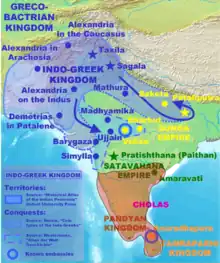| Greek Invasions Of India (2nd Century BCE) | |||||||||
|---|---|---|---|---|---|---|---|---|---|
 Extent of Shungas after repulsing the Greek invasions c. 150 BCE.[1] | |||||||||
| |||||||||
| Belligerents | |||||||||
| Greco-Bactrian Kingdom | Shunga Empire | ||||||||
| Commanders and leaders | |||||||||
| Demetrius or Menander I[5] | |||||||||
| Strength | |||||||||
| Unknown | Unknown | ||||||||
| Casualties and losses | |||||||||
| Unknown | Unknown | ||||||||
The Shunga-Greek War was a number of Conflicts fought between the Shunga Empire and the Greco-Bactrian Kingdom. The Greek Ruler Demetrius is regarded to have invaded the Subcontinent after his win over the Kabul Valley.[7] However, the outcome of the war remains uncleared but the Shungas were successfully able to resist the invasion and expel the Greeks out of Mathura.
The Invasion

The first phase of the invasion starts with the Greek ruler Demetrius I Conquest of the Kabul valley. He invaded the Indian Subcontinent during the rule of Maurya Empire. He firstly invaded the province Arachosia and was successful in taking control of the region. He then decides to raid the eastern territories of the Subcontinent. He raided the Punjab region and again gained success. He may have the control on the Indian territories of Mathura and Patliputra for a short period of time
"Those who came after Alexander went to the Ganges and Pataliputra" (Strabo, XV.698)
The Indian texts also suggest that the Greeks gained control on the territories of Saketa, Panchala, Mathura and Pataliputra (Yuga Purana).
However, Demetrius is said to be have invaded only the northern territories of India. Later conquests had been done by Menander. The Indian text Milinda Panha describes him as
King of the city of Euthymedia in India, Milinda by name, learned, eloquent, wise, and able; and a faithful observer, and that at the right time, of all the various acts of devotion and ceremony enjoined by his own sacred hymns concerning things past, present, and to come. Many were the arts and sciences he knew--holy tradition and secular law; the Sankhya, Yoga, Nyaya, and Vaisheshika systems of philosophy; arithmetic; music; medicine; the four Vedas, the Puranas, and the Itihasas; astronomy, magic, causation, and magic spells; the art of war; poetry; conveyancing in a word, the whole nineteen. As a disputant he was hard to equal, harder still to overcome; the acknowledged superior of all the founders of the various schools of thought. And as in wisdom so in strength of body, swiftness, and valour there was found none equal to Milinda in all India. He was rich too, mighty in wealth and prosperity, and the number of his armed hosts knew no end.
The first phase of the invasion ends here and there incomes a civil war in Bactria. The King Demetrius[8] returned back to Bactria leaving his Governors to rule.
Repulsion of the invasion
After the return of Demetrius I to Bactria, Pushyamitra decided to take back the lost territories of the Subcontinent back from the Greeks. Vasumitra, the Grandson of Pushyamitra Shunga was sent to protect the horse of Ashvamedha on the banks of river Indus.[9] He was successful in defeating the unit of cavalry of the Greeks[10]. The territory of Shungas now extended from the Himalayas in the north to the Berar in south and from Sagala to Magadha in the west.
Aftermath
The Indo-Greeks and the Shungas seem to have reconciled and exchanged diplomatic missions around 110 BCE, as indicated by the Heliodorus pillar, which records the dispatch of a Greek ambassador named Heliodorus, from the court of the Indo-Greek king Antialcidas, to the court of the Shunga emperor Bhagabhadra at the site of Vidisha in central India.[11]
References
- ↑ Schwartzberg, Joseph E. (1978). A Historical atlas of South Asia. Chicago: University of Chicago Press. p. 145, map XIV.1 (c). ISBN 0226742210.
- ↑ A Journey Through India's Past Chandra Mauli Mani, Northern Book Centre, 2005, p.39
- ↑ Sen, Sailendra Nath (1999). Ancient Indian History and Civilization. New Age International, 1999. p. 170. ISBN 978-8-12241-198-0.
- ↑ Lahiri, Bela (1974). Indigenous States of Northern India (Circa 200 B.C. to 320 A.D.) Calcutta: University of Calcutta, p.51
- ↑ Raychaudhuri, Hemachandra (1923). Political History of Ancient India. University Of Calcutta. p. 205.
- ↑ Lahari, Bela (1923). Indigenous States of Northern India (PDF). University Of Calcutta. p. 51.
- ↑ Mauli, Mani (2005). A journey through India's Past. Northern Book Centre. p. 38. ISBN 9788172111946.
- ↑ Raychaudhuri, Hemachandra (1923). Political History of Ancient India. University Of Calcutta. p. 205.
- ↑ M.A., C. H. TAWNEY (1891). THE MALAVIKAGNIMITRA A SANSKRIT PLAY BY KALIDASA (2nd ed.). p. 91.
- ↑ MAULI MANI, CHANDRA (2005). A Journey Through India's Past. Northern Book Centre, New Delhi. p. 39.
- ↑ Ravindran, T.K. (1973). Journal of Indian History. Vol. 51. Department of Modern Indian History. p. 441.
Further reading
- Raychaudhuri, Hemachandra (1923). Political History of Ancient India. University Of Calcutta. p. 205.